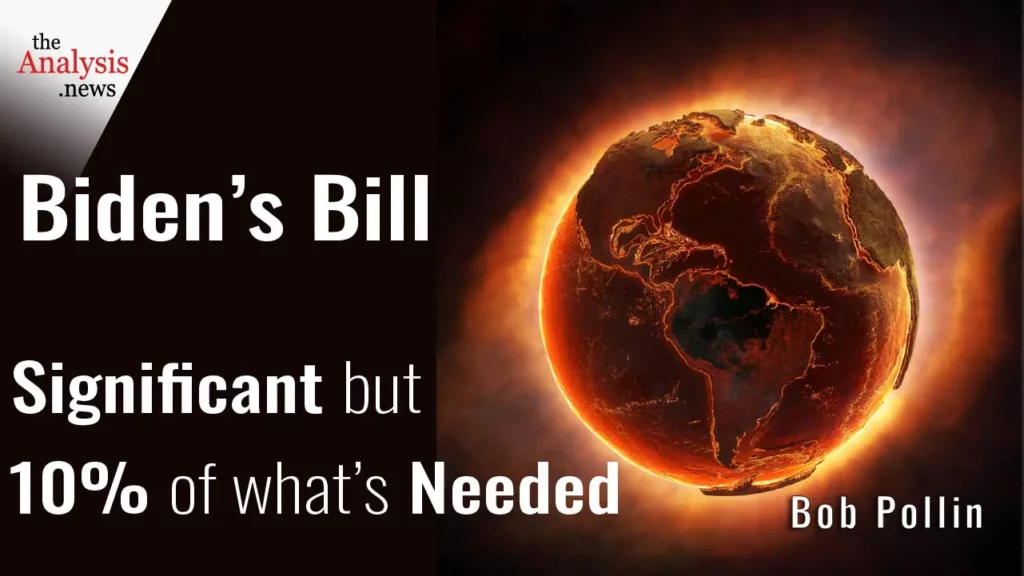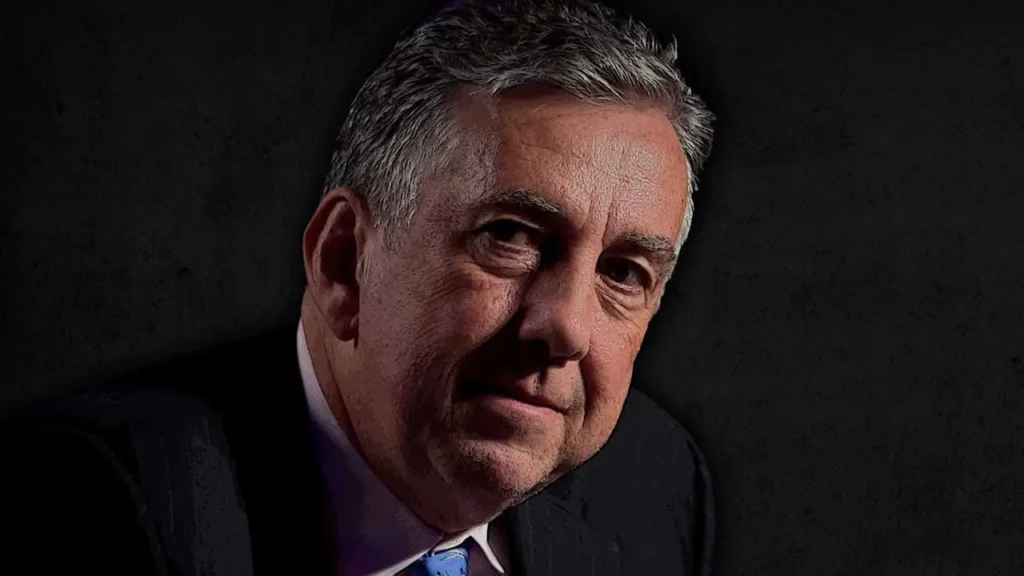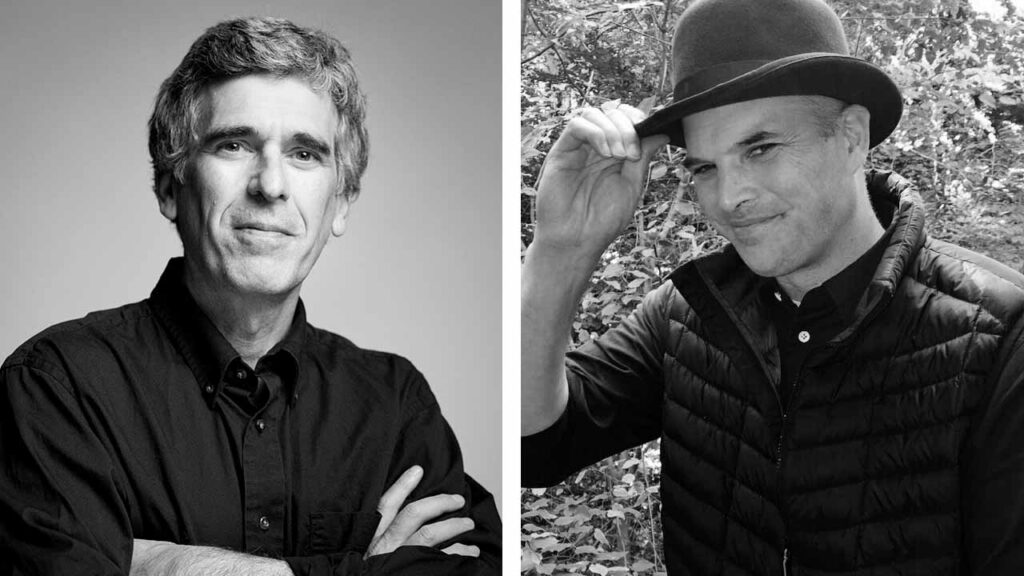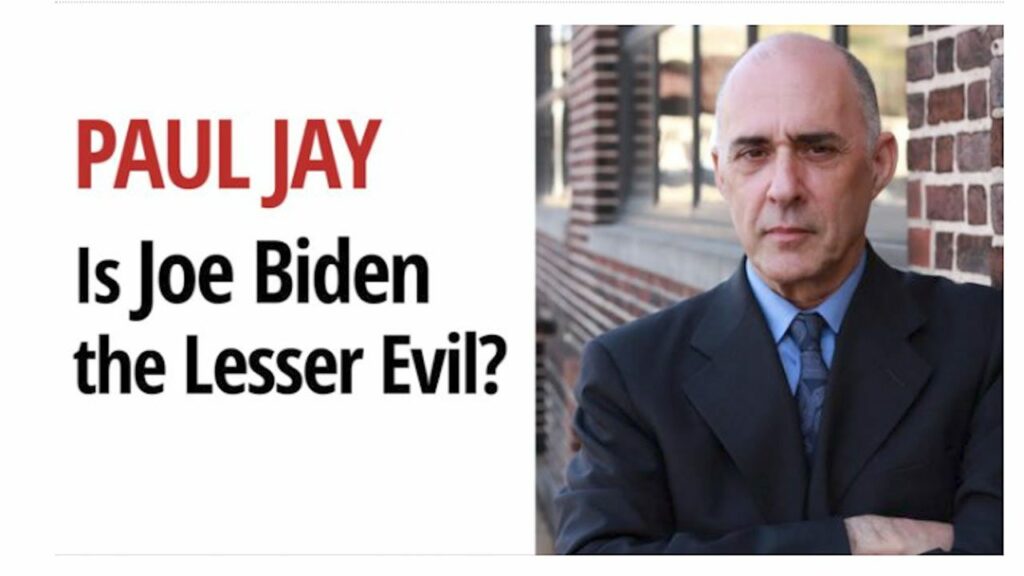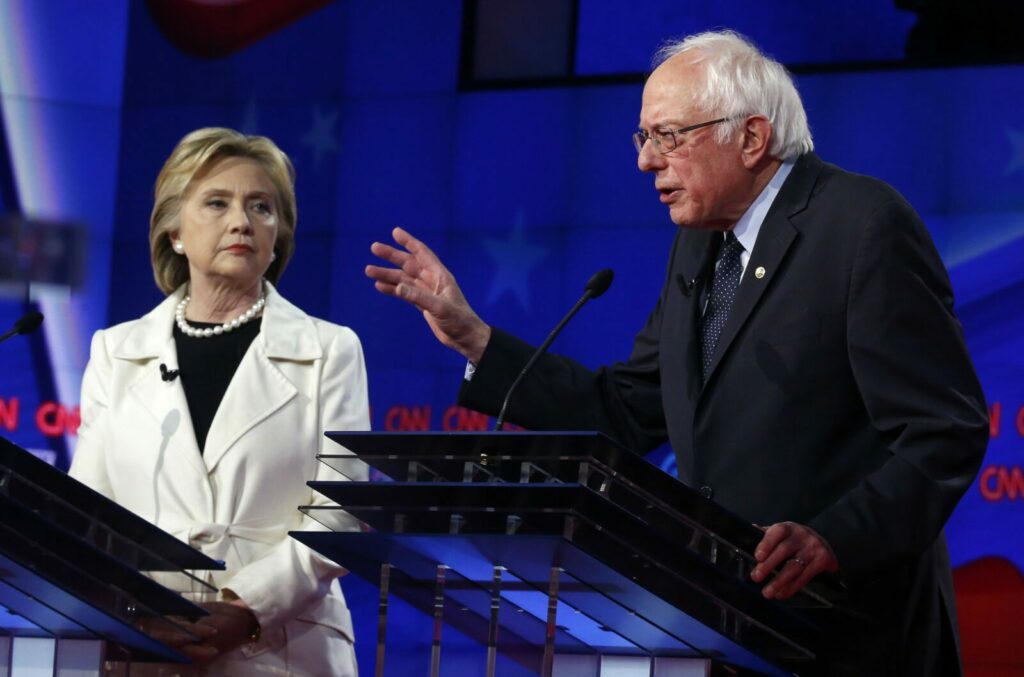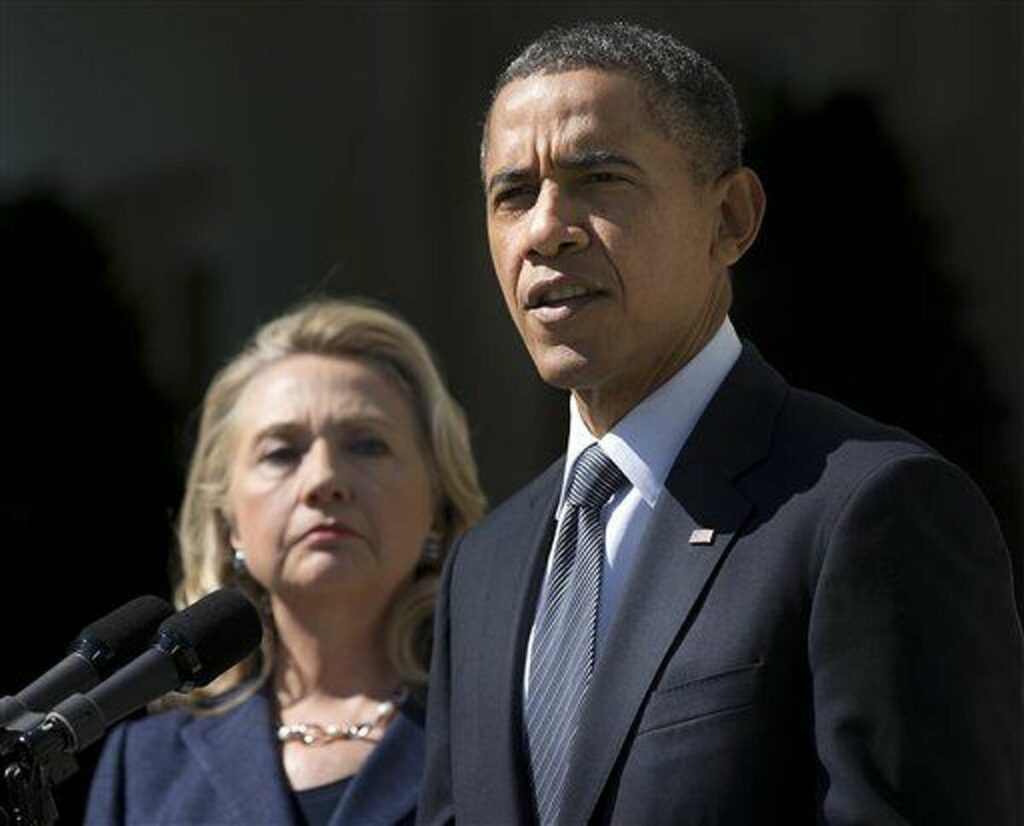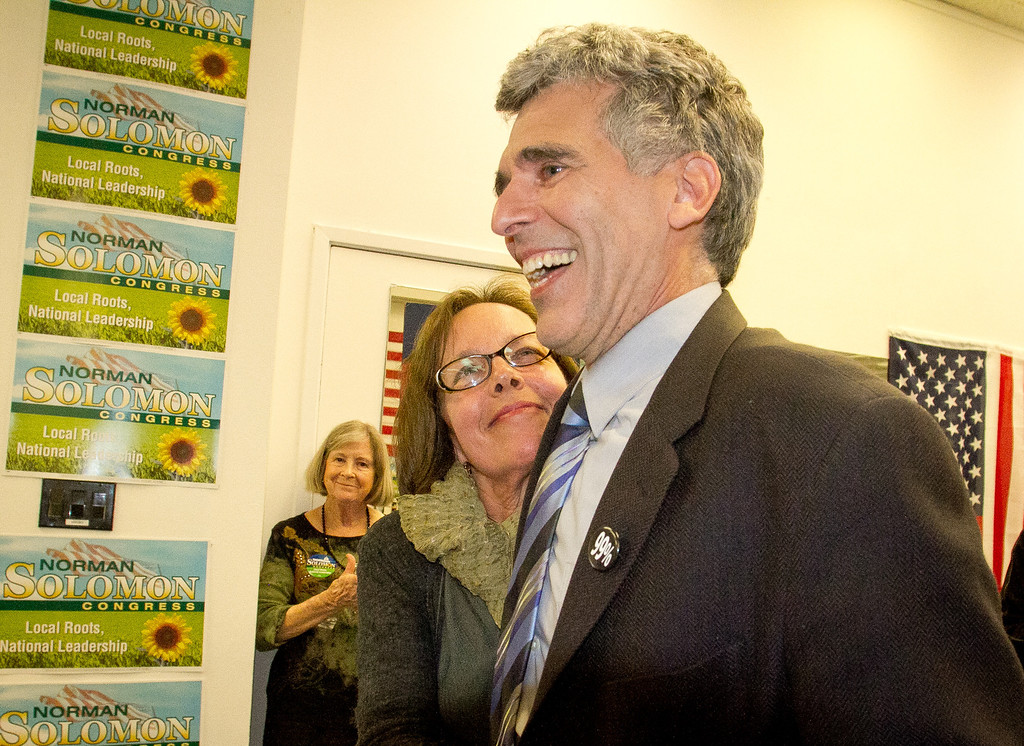The so-called “Inflation Reduction Act” will have a positive affect on the climate crisis, but it does not phase out fossil fuel and is far from what’s needed. Big industrial states like New York and California can and must go much further. Bob Pollin on theAnalysis.news with Paul Jay.
Paul Jay
Hi. Welcome to theAnalysis.news. I’m Paul Jay. In a few seconds, we’ll be backing back with Bob Pollin to discuss the Biden/Manchin bill that hopes or says it’s going to address the climate crisis. Don’t forget, we have a donate button. If you don’t give, we can’t do this. Most importantly, get to the website and sign up for our email list.
As reported in the Guardian, the bulk of the Biden-Manchin Inflation Reduction Act, as it’s called, which contains around $369 billion to combat climate change, “allows for large tax credits for clean energy, such as solar and wind power, to allow such projects to go ahead on a grand scale.”
The Guardian says, “states and utilities will also get $30 billion to help the transition to renewable, zero-carbon electricity. A new $27 billion “clean energy technology accelerator” will be created to help advance renewable technologies, $3 billion will be given to the U.S. postal service to electrify its fleet of trucks, and there will be a new program to drive down leaks of methane, a potent greenhouse gas, from oil and gas drilling operations. A further $20 billion will be spent to promote climate-friendly agricultural practices and another $5 billion to make American forests better prepared for the wildfires that increasingly threaten them due to global heating.”
“There is also a $9 billion scheme focused on low-income households, to electrify home appliances and make dwellings more energy efficient. Further tax credits, spread out over the next decade, will make it easier to buy heat pumps, rooftop solar, and water heaters.”
“Disadvantaged communities that suffer the brunt of fossil fuel pollution have also been recognized, with $60 billion dedicated to environmental justice projects across the U.S.”
“The bill doesn’t include any mechanism to specifically phase out fossil fuels, the primary cause of the climate crisis, and, indeed, looks to lock in their use for decades to come due to a compromised struck with Manchin. Under the deal, regulations around drilling will be loosened, and new leases will be offered in places such as the Gulf of Mexico and Alaska. Environmentalists have called this arrangement “a climate suicide pact”.
“The bill is expected by both its authors and some independent analysts to allow the U.S. to cut its emissions by 40% by 2030, based on 2005 levels. This, they say, brings the U.S. close to Biden’s goal of slashing emissions in half this decade, which scientists have said is imperative if the world is to avoid catastrophic climate change.”
Again, that’s from the Guardian.
Now joining us to assess the Inflation Reduction Act is Bob Pollin. He’s the co-founder and director of the PERI Institute at the University of Massachusetts, Amherst. He’s the author with Noam Chomsky of Climate Crisis and the Global Green New Deal.
So, Bob, there are three main areas of the bill I think we should talk about. One, does it really have anything to do with lowering inflation? Two, what happened with all the taxes on the rich Biden had promised? And three, and let’s start with, and, perhaps, the most important issue, does it address the climate crisis? Is the bill in category (A) Far from what’s needed? (B) Better than nothing. (C) Actually could be good. (D) All of the above. What do you think, Bob?
Bob Pollin
D. All of the above.
Paul Jay
I figured you’d go there. Alright, okay, go ahead. Why?
Bob Pollin
Yeah, well, (A)— okay, we can’t keep doing the same numbering. It’s definitely way better than nothing, and two weeks ago, we thought we had nothing, which talking about the climate catastrophe that you just quoted, we were certainly on a track to climate catastrophe as of two weeks ago when Manchin, at least according to reports, walked away from any agreement. What we have now is a significant intervention. It is certainly not adequate. All the problems you just mentioned are certainly incorporated into it, including what you said about allowing for fossil fuel development, in fact, encouraging and supporting it concurrent with these clean energy investments.
The level of clean energy investments, as you said, is in the range of $40 billion in public funding. According to my own estimates, what we really need to hit the 2030 emission reduction target at 50% is in the range of $400 billion a year. So, we are at or around 10% of that.
Paul Jay
Hold on. You just said $400 billion.
Bob Pollin
Right, so the bill allocates—
Paul Jay
Hold on. Just to be clear, maybe you could say— just remind us. The bill is over ten years. You’re saying it should be that much every year.
Bob Pollin
The bill is at roughly $400 billion for ten years. So divide by ten, that’s about $40 billion per year. According to my own work, we need in the range of $400 billion per year to build a clean energy infrastructure that will enable us to get to roughly 50% emission reduction. So this bill would get us about 10% of the way through public spending.
Now, we could get to $400 billion a year through leveraging that $40 billion with private investments. My estimate, a conservative estimate, is this bill would get us up to about $100 billion total, including public plus private, through the tax credits and the loan guarantees for private capitalists. So we’re still likely about 75% less than where we need to be. We’re about 25% of the way. The way that we could get all the way there is through organizing and getting state governments, municipal governments, and institutions to insist, unlike my own institution, the University of Massachusetts, is committed to zero emissions by 2032. If private institutions say, hey, you know what, we’re not buying any more oil, gas, and coal, just not doing it, we can get there.
This bill helps, but it certainly does not provide on its own sufficient resources to get to that level.
Paul Jay
Now, in previous conversations we’ve had about the Biden plan, both from when he was campaigning and even that Build Back Better Bill, which is dead now, there was a heavy reliance on carbon capture and supposedly clean carbon technology, which more or less doesn’t exist at a scale that’s going to be meaningful. I can’t tell, is this money going at all to the clean carbon kind of idea, or is it really focused on sustainable energy: wind, solar and such?
Bob Pollin
So if you read through the details of the bill, as I’ve done, the explicit allocation for carbon capture is relatively modest. It’s about 300 something million per year, so it’s less than 1%. On the other hand, there are these broad categories called clean electricity and clean fuels. It’s still up in the air, the extent to which those general categories, clean electricity, will incorporate support for carbon capture. Given that the grand deal that made this all happen was Manchin insisted that the Biden administration support the development of this natural gas pipeline through West Virginia, the so-called Mountain Valley Pipeline, that’s going to build in fossil fuel production development for decades. Why bother to build the pipeline if you’re not going to use it?
Therefore, if we’re building in increased fossil fuel production, if we’re going to get anywhere close to these emission targets, we have to increase carbon capture. I’m not in favor of carbon capture. As you said, there’s no evidence that we can produce carbon capture commercially, even if you liked it. That has to be a big part of the bill, even though in its current definition, these specified programs, the extent of funding for carbon capture is relatively modest. On the other hand, the extent of support for nuclear is quite large. So nuclear is a big part of this bill.
Paul Jay
What do you think of that?
Bob Pollin
Well, I’m against it. There are debates on the Left about how much we need to rely on nuclear. I don’t see it. Other people, such as the great climate scientist James Hansen, are saying we cannot get to a climate stabilization path without depending primarily on nuclear as the alternative. I think that courts all kinds of dangerous, disastrous prospects, including all the issues around radioactivity, including the issues around safety and political takeovers, like what we just have seen in Ukraine.
Where did the Russian forces go in the first week? They went to Chernobyl, they went to the other site, which I can’t pronounce, Zaporizhzhia, the biggest nuclear site in Europe, and they took it over. Now, what were they going to do with it? Of course, that remains an open question.
So I don’t see nuclear— I see nuclear as maybe a subsidiary to an overall renewable, founded, a renewable dominant alternative energy system that could be constructed through this bill. We really have to fight for it because, as it is, nuclear is a big part of the overall story. Carbon capture is likely to be. So solar and wind are definitely there, but we need to really push to advance those relative to nuclear and carbon capture.
Paul Jay
I’ve also understood that even if one was in favor of nuclear, it’s highly unlikely it could be a significant factor within seven, eight, and nine years. It just takes a lot longer to finance and build these things. Something radical has to happen in seven, eight, and nine years.
Bob Pollin
Even on cost, carbon capture, first of all, there’s no large-scale commercial operation of carbon capture at all anywhere in the world despite decades of trying. Of course, why wouldn’t they try? This is the way that the fossil fuel industry thinks it can survive. Okay, so that’s carbon capture.
Nuclear, costs have gone up and continue to rise. Yes, that’s largely due to building-in safety measures. The proponents of nuclear saying these safety measures are excessive. Well, really? I don’t think so. Especially if we’re talking about the new ideas, smaller scale, modular nuclear plants, well, that seems to me is only going to increase the risks associated with nuclear because there’s going to be smaller ones spread out more. Therefore, all of the issues with respect to making them operate safely, guarding them, and so forth just get dispersed. Not—
Paul Jay
This is the plan Bill Gates is promoting.
Bob Pollin
Yeah, Bill Gates, among others. Yes. Meanwhile, the cost of solar and wind are falling dramatically. The cost of solar per unit of electricity has come down almost 90% in a decade. I mean, this is remarkable. So whatever else one may say about solar and wind, at this point, they are the low-cost alternative for electricity generation globally.
Paul Jay
They are so long as this tension with China doesn’t break down to a trade war, given how dependent the world is on Chinese solar.
Bob Pollin
Yeah. If we want to say yeah, how did solar come down 90% in a decade? To summarize it in one word, China. They’re the ones that are producing the cheap panels. Now, of course, we could do it in the U.S. We just haven’t. So maybe the subsidies that are built into this bill will accelerate U.S. development to a significant extent. That would be fine. We should be competing. We should be in other places as well.
Paul Jay
So when I gave you door (A), door (B), et cetera, and you picked all of the above, all the things that I listed in that list of things where money is going to go, it all mostly sounds good. But the but is a pretty big but. If you’re not actually phasing out fossil fuel, and, in fact, you’re opening doors to more fossil fuel, then is this actually in the end, okay, it’s nice, but given we’re facing an existential crisis, is it window dressing that allows Biden to say he’s done something when he’s not really facing up to the scale of the crisis?
Bob Pollin
Well, I mean, let’s look at the political reality today. There’d be no Bill without Manchin or [Kyrsten] Sinema. Sinema wanted the tax cuts on rich people eliminated. Manchin wanted the pipeline for West Virginia. Manchin, my understanding, reading the tea leaves, Manchin waited until the last possible moment to support anything because after– Congress is going on break next week, and they won’t come back till September. Then they’re all running for office. So this was it. He really wanted that pipeline. So this was his bargaining chip. He’ll support a Bill as long as he gets his pipeline for West Virginia, which of course, at least logically, builds in fossil fuel production and distribution for decades, including fracking, of course. So that’s what we have. What was Biden supposed to do? I don’t know, get more votes? Do we know what’s going to happen in November?
So the real thing, having thought about it, again, I think this is way better than nothing. This is real money. This is hundreds of billions of dollars, and then we have to mobilize around— we can stop fossil fuel consumption just by saying we stop fossil fuel consumption. So like my university says, zero. We’re going to zero. Private institutions, municipalities, and states can vote on regulations. If you build in these regulations at the state level, and we can force the fossil fuel companies to maybe obey the law, that’s the way through which we can build on this, let’s say, mediocre Bill. Not terrible, mediocre, and move towards a real solution.
Paul Jay
Now, in terms of the money that’s going towards sustainable energy, do you get a sense of what that really means? What are these subsidies?
Bob Pollin
Well, okay, so in this study that myself and my coworkers put out yesterday, we divide up every single program, every single detailed program within the bill.
Paul Jay
And people can find this on the website of PERI Institute, right?
Bob Pollin
Yeah, as far as I know, it’s the only study out that has estimated the employment impacts of this bill. So we divide the programs into one in which there’s only government spending, ones that are effectively subsidies for private spending, including corporate investments, but also consumers to buy heat pumps or electric vehicles. Then third, loan guarantees, which are also subsidies for private banks to make green loans. So if we think about those three different categories, the subsidies are there for private businesses, building owners, including homeowners, and people who are buying cars. So there is a good chunk of money. So there’s $7,500 for anyone that wants to buy an electric vehicle. Electric vehicles cost, I don’t know, about $30-35,000. So that is a substantial subsidy for private people. Now, people argue, well, it’s still too much. Most people are still not going to spend the money on an electric vehicle.
Paul Jay
Or you have to change how electricity is being generated because if you’re plugging your car and the electricity is coming from coal—
Bob Pollin
So those things have to happen in combination. So that’s why, at the state level, if we can insist that the utilities keep increasing their share of renewable electricity, then we’re okay. Now, it may be that the utilities are going to look at the same studies that I look at and see that, you know what, investments in green energy are good for us because they’re cheaper than generating electricity through coal. They’re more or less at parity with fracking. With fracking and regulations, they’re better off building capacity, new capacity with solar and wind. So that’s the things around which I think labor and environmental activists need to organize and make this really clear.
Paul Jay
I think a word you keep mentioning is kind of the critical piece of all this. To some extent, it’s going to come down to whether, if this isn’t done, human society as we know it isn’t going to be around in a few decades. You said at the state level, and it seems to me that federal politics is so paralyzed. This bill is, like you say, better than nothing. If there’s no actual phasing out of fossil fuel, just based on what I understand of the science, there’s no way of reaching any significant targets from this bill. If the big states like New York, California, and maybe Illinois, states with big cities that vote for Democrats but also might vote for progressive Democrats, actually get serious about climate— a lot of the corporate Democrats, and I don’t even mean as far-right as Manchin, aren’t serious about taking on the fossil fuel companies. Biden clearly never has been. If this doesn’t happen at the state levels, then I think we’re screwed. Maybe it could happen at the state level because some of these big states could do something significant and maybe even put some pressure on the smaller fossil fuel states.
Bob Pollin
Well, I mean, let’s just think about California, which is roughly 15% of U.S. GDP, and even more, if we think about, say, the market for cars and the market for electric heat pumps. If they build in regulations that require no more sales of fossil fuel-powered cars, no more conventional air conditioning or conventional heating, cooling, and ventilating systems, and alternative electric heat pumps, if they establish regulations along those lines, then the manufacturers are going to build for the California market. They’re going to build for the New York market, as was the case when California first set its efficiency standards for fossil fuel-based cars. That then transformed the market and ushered in this era of hybrids and much more efficient cars. Yes, fossil fuel-generated powered cars.
This bill, as I said, it’s not nothing. It is real money. On top of it, if these major Democratic-controlled states and municipalities really establish stringent regulations and further support for clean investments— so, for example, this bill gives you $7,500 if you’re going to buy an electric vehicle. What if California taxes on another $5,000? That will certainly give a lot of impetus for purchases in California, which is 15% of the whole economy. So that’s the kind of dynamic.
On top of that, if we think about our institutions that we have some control over, such as universities, and religious institutions, if the big universities, one by one, do what my university has done under the enlightened leadership of our current Chancellor [Kumble R.] Subbaswamy, if we insist do what it takes, we’re going to be at zero by 2032. I was at the meeting when our Chancellor told the committee that I was on, students, faculty, administrators, bureaucrats, and of course, people were telling him it’s too expensive, we can’t do it. It’s complicated. The students fought for a serious commitment and firm commitment, and the Chancellor backed them. So here we are.
Paul Jay
It’s a good thing, but it’s not going to deal with the—
Bob Pollin
Of course, it’s one place, but—
Paul Jay
At the state level, even if New York and California started to pass— they can pass legislation to phase out fossil fuels, can’t they? It doesn’t have to happen at a high level.
Bob Pollin
Yeah, they can. New York, California, as you said, Illinois, so now you’re at something like 25% of the economy. Yeah, that would be really foundational. It would establish this framework which can use this bill, the Inflation Reduction Act, so-called. We certainly don’t want to sneeze at $35 billion a year in available funds. It’s not enough, but it’s certainly not nothing.
Paul Jay
Now, before we just move quickly to the other two categories to talk about in terms of this bill, you’ve done some modeling. There’s a lot of talk about what will happen to employment. You’ve actually done some work on what the employment consequences of this bill will be. What did you find?
Bob Pollin
Yeah, myself and co-authors Chirag Lala and Shouvik Chakraborty did a lightning-fast study that went out yesterday. We started it four days ago. We modeled every single item in the Inflation Reduction Act. Overall, what came out is that the bill, if we factor in, conservatively, private spending induced by this $40 billion, roughly, we’re at a little less than $100 billion per year overall in spending. That, we estimate, is going to generate about 900,000 jobs. So again, it’s not huge, but our labor force is 164 million. So this is about a 0.6% injection of new employment into the U.S labor force.
So it’s certainly pushing in the right direction. I’ve had some discussions with members of the press, the mainstream press already, in which they say, wow, what a great idea that a climate program could actually be good for jobs. Well, that’s always been true, but it’s good to see that it’s catching on.
Paul Jay
Somebody said what you said was a paradigm shift. I’ve been saying this for 15 years.
Bob Pollin
Yeah, well, yeah. This particular journalist said, well, think about this in terms of Ohio, where you have this right-wing Trump guy, [James David] Vance, running for Senate and saying these green projects are job killers, and we need to defend what we have in terms of the fossil fuel industry. Well, I already did a study on Ohio, I don’t know, two years ago, showing that green investments are far more supportive of job creation and economic opportunity than any kind of program to protect fossil fuel jobs. Yes, this certainly fits within that framework.
Paul Jay
Let me just say again, because I think it’s so important. The idea that the Senate is paralyzing climate policy, essentially, because Republicans due to the freaky American system that gets two senators to every state no matter what size it is and a stupid thing called the Electoral College, that, in fact, isn’t really paralyzing everything because the states that could take significant action are essentially controlled by Democrats. So in many ways, the actual fight is with corporate Democrats who run those states and could have been doing so much more and aren’t.
Bob Pollin
Well, yeah. So we have to recognize that all 50 Republicans, it’s just a given that we can’t get a single Republican from any state to support any semblance of this kind of measure, even this kind of relatively weak measure that we’ve got now. If we had one or two Democrats, then we wouldn’t care. We wouldn’t care about Joe Manchin. No one would have ever heard of him. It’s only because there is not a single Republican, which was not true not that long ago. When [John] McCain was running for president in 2008, he had a climate provision in his overall platform. It wasn’t that good, but he was acknowledging the importance of doing something. Now you can’t get a single one to do it.
Paul Jay
Yeah, even Newt Gingrich acknowledged it about 12-13 years ago or something. Not anymore.
Bob Pollin
Right.
Paul Jay
Well, before we end here, let’s just finish talking about the bill. First of all, why on earth is it called the anti-inflation? What the hell does this bill even got to do with inflation?
Bob Pollin
Well, okay, you could say that there are two provisions— independent of all the climate stuff, there are two provisions that we could say are consistent with dampening increased prices. Number one is all the health care stuff, which is very, very modest. Relative to the climate stuff, it’s even more modest. The one thing that may be relatively significant over time is the capacity of the government to bargain with pharmaceutical companies over the prices of prescription drugs. So if that were integrated incorporated, that would put some downward pressure on prices over time. It’s not going to have anything to do with inflation today. Zero.
Then this idea of reducing the federal deficit, again, maybe almost nothing in terms of weakening demand in the economy, which then puts some very modest downward pressure on prices. You could say, favorably, that, oh, we’re building in green infrastructure, green energy infrastructure, and green energy is now cheaper than fossil fuels. So that becomes anti-inflationary. So all of these things, you could say, have some anti-inflationary components that could work themselves out over the next five, six, seven years. They’re not going to have anything to do with the current bout of high inflation.
Paul Jay
Which has to do with high energy costs, supply chain issues, and has absolutely nothing to do with the size of the American deficit. It’s kind of a joke because the more the crisis is, the higher the American dollar goes. Everyone keeps buying American dollars. So this idea that somehow no one’s going to have faith in the dollar or our debt is too big; it’s just ridiculous. That dollar is never— I don’t know if it’s the more Russia invades Ukraine, the more people want the U.S. dollar.
Bob Pollin
On top of that, we’ve talked about this before. If we say that a part, or maybe a third of the inflationary pressures, is coming from modest wage increases, well, that’s favorable. We want that. Workers deserve raises, and the raises should be higher than the rate of inflation so that they bring home more money and more purchasing power. That hasn’t happened because, in addition to the wage increases, we’ve also had, as you said, the supply chain shortages, which have driven up prices and the monopolistic power of oil companies and other big corporations along the supply chain. So that’s driven up inflation, double the rate of wage increases.
Paul Jay
All these tax increases that Biden had said he was going to bring in on the rich, he had to give up on all of them. I don’t know if he was that reluctant to give up on them, but he did under the pressure of Manchin. I personally wouldn’t mind giving up on the tax increases if there was a far stronger climate bill. If you want to bribe the rich to go along with phasing out fossil fuel, okay, for a few more years, bribe the rich, but they didn’t phase out fossil fuel.
Bob Pollin
The other way that the rich are getting bribed is, of course, through all of the tax incentives, tax credits, and loan guarantees to build a green economy. A very high proportion of that will go to rich people who are investors. So we’re in a capitalist economy, and that’s kind of the reality. It would be great if it were otherwise, but that’s not where we are.
Paul Jay
Well, but that’s part of the problem. If you don’t phase out fossil fuel and you do all the other stuff, it’s good, except it becomes a boom for finance who are going to financialise the way all of this gets done. I just think it’s very important to keep stressing the lack of the phasing out of fossil fuel, and stress again the role states can play in doing this because it doesn’t have to be hopeless. If you’re in a state where the Democrats control it, then you’re fighters with corporate Democrats that won’t take this kind of climate action, and they can keep blaming the Republicans. You can’t blame the Republicans in states where the Republicans can barely get elected.
Then there’s another thing coming. It’s very possible and likely the way things are going that the Republicans, and when we say Republicans now, to a large extent, we have to say Christian nationalists. It’s the real far-right that’s going to take over at least one House, if not both Houses of Congress, in 2022. They might end up with the presidency in ’24. They more or less— not more or less, have the Supreme Court.
So this federal government controlled, perhaps, by very rabid right-wing forces is really going to come into contradiction with the populations, especially in the big states like in New York, like in California, like in Illinois, and a few others. People living in those states and other states where progressives, in the broadest sense of the term, better start thinking about what this country is going to look like. If the states don’t step up, the ones that don’t want to live under a Christian theocracy, climate science deniers, it’s up to these states to do it.
Bob Pollin
I mean, I think having been involved in both New York and in California, I think there’s a very robust movement and alliances between environmentalists and labor, which I think is the core of accomplishing exactly what you’re talking about. I think they’re doing well.
For example, in California, even the Oil Refineries Workers Union has endorsed a very aggressive green transition program. They are only one union, but I mean, that’s really significant. Oil refinery workers make a very good standard of living through the fossil fuel industry, and they recognize that we have to make a transition. They have to be supported through the transition. So it’s those kinds of measures supporting the transition for people and communities that are dependent on the fossil fuel industry, I think, that will shift the tide in these states. Colorado is another one that is kind of in between. It has a pretty robust fossil fuel industry. They’re willing to support a transition to a green economy if it includes support for workers and communities that are currently fossil fuel dependent.
Paul Jay
Even that’s another thing that could be fought at a state level. If California and New York got together and said to fossil fuel states, even if the federal government won’t fund a just transition, we will. I mean, California and New York got a lot of money.
Bob Pollin
Yeah, I agree that working at the state level is really critical. That said, I think that this bill if it passes, the good parts are helpful. The bad parts are awful. We have to work on minimizing the negative impact of the bad parts.
Paul Jay
Alright, great. Well, thanks very much, Bob.
Bob Pollin
Great. Thanks for having me on.
Paul Jay
Thank you for joining us on theAnalysis.news. Please don’t forget your donations keep us going, and get on the email list. Thanks again.
[powerpress]
[simpay id=”15123″]
Robert Pollin is an American economist. He is a professor of economics at the University of Massachusetts Amherst and founding co-director of its Political Economy Research Institute. He has been described as a leftist economist and is a supporter of egalitarianism.
